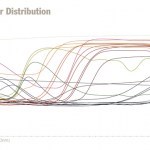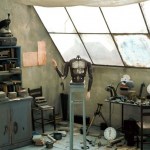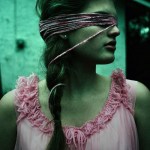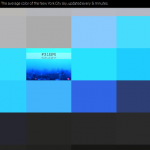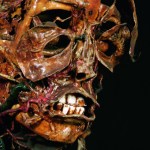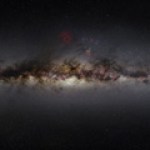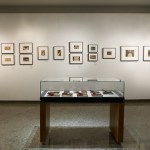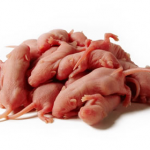Photography
Self confessed geek and photographer Mark Meyer makes images that "narrate, persuade, inspire and inform". He wanted to know the exact colours present in his pack of crayons. What to do then, but put them through a spectrophotometer?
Mark says:
These questions have been nagging me since kindergarten and this weekend I finally got to the bottom of it. I am now able to answer that age-old question: what really is the difference between green-yellow and yellow-green?
Many more nerdy charts and breakdowns at Mark's website.
Came across this viper on a bike path one evening in July. It got shy when we stood around admiring it, so it disengaged from the shrew and slithered off into the greenery. May have saved it from getting run over by a bike.
In a guest post at Scientific American, Rebecca Jablonsky says,
Kuhn de-legitimized the understanding of science as implicitly including objective reality, leaving room for theory to de-stabilize rituals of practice and produce authentic innovation-something that is certainly prized in both artistic and scientific communities alike.
Seriously - go read it and come back. It's short. I'll wait.
So I don't get it. While Jablonsky's post is well-written and thoughtful, and I basically agree with everything she says, and find the concepts interesting, I can't figure out who the post is intended to…
L'Automaton #06, 2010
Paolo Ventura
(zoom view available here)
Artist-photographer Paolo Ventura constructs and photographs miniature, dreamlike scenes. His Winter Stories represent the reminisces of an old circus performer. Above, a scene from the Automaton series captures a mysterious, half-built android. Who is the android's creator? When and where is this happening? Ventura's work is evocative precisely because it is so mysterious. (It turns out that Ventura's backstory for the Automaton series involves a lonely watchmaker in the Jewish ghetto of 1942 Venice - but still, that hardly…
Untitled, from "The Others"
Jordan Tiberio
My favorite thing about the internet is serendipity. Click here, click there, and the next thing you know you're scrolling down the gallery of an 18-year-old photographer whose artistic sensibility seems equal parts 1970s fashion magazine, pre-Raphaelite fairy tale, and Sigur Ros music video. Lovely young women are hardly an original topic, but Tiberio's work seems to catch a disquieted, ambivalent undertone to the beauty. Is it ambivalence about the artifice of fashion, about aging, about one's own body and sexuality? I have no idea, but I'm…
Note: except for the fact that it was in Washington DC, I don't remember where I took this photo. . . :)
Artist Mike Bodge has unveiled a nifty project to chart the colour of the sky above New York City in real time. A camera installed in his office snaps a picture of the skyline every five minutes, and analyses the image to calculate its average colour. The varying shades of blue, grey, orange and black are posted online in a never-ending mosaic.
Mike says:
Many of my projects tend to be about New York City, as it's a place i'm constantly inspired by. I have a great view at my office overlooking the East Village neighborhood and I've done time lapses and other things but none really…
The rivers run almost dry in Qingtian prefecture, Zhejiang province, China, because of recently built power dams. This particular dam on a tributary of the main river was completed three years ago. The resulting lake is 100 meters deep above the drowned villages on the valley floor.
And if they didn't build these dams? Either burn coal, build more nuclear plants or stay an undeveloped nation.
Cultivation terraces and tombs that were once way up the mountainside and hardly accessible at all are now at the lake shore. Note the zone of silt-grey terraces just above the current water level…
If this luminous, high-definition, time-lapse film of Arctic skies and seas by Norwegian photographer TSO (Terje Sorgjerd) doesn't vaporize your stress in under three minutes, I don't know what will. Be sure to click the video controls to view full-screen - this one is worth it.
Via Andrew Sullivan.
My mother-in-law grew up in the mountains near Fushan in the prefecture of Qingtian (pronounced CHING-tien), inland Zhejiang province. Though the prefecture's name means "Green Field", it's pretty poor and has been a major emigration area for decades. The owners and staff of many or most Chinese restaurants in Sweden are from Qingtian. Yesterday we rode a train for nearly seven hours from Hangzhou to get to the district capital, and all along the way we were accompanied by a line of enormous new concrete stilts on which a future fast railroad will run. Next time the trip may take only an…
. . . they could have. Or pretty darn close, at least - they just needed to visit one of the many European cabinets of anatomical curiosities, to see the work of anatomists like Honore Fragonard.
Fragonard's eighteenth-century ecorches were the clear precursors to Gunther von Hagens' "Body Worlds" exhibits: preserved, injected, partially dissected bodies in lifelike, dramatic poses, with ragged strips of muscle draped like primitive clothing over exposed vessels and nerves. The effect is eerie - like a Vesalius illustration sprung to (half-)life:
Man with a Mandible
Several of Fragonard's…
If you haven't already seen the Photopic Sky Survey, you really should. Nick Risinger toured the world's least light-polluted sites to photograph and stitch together this 37,440 exposure, 5000 megapixel image of the night sky. I honestly don't think I've ever appreciated the sheer number of stars out there as much as I did this morning, zooming in on Nick's amazing panorama. Someone really needs to mash this up with a Carl Sagan monologue or something, because anything I could say about our relative insignificance in the universe would be inadequate.
Through the end of May, UMBC's Albin O Kuhn gallery is hosting a large exhibition of postmortem daguerreotypes, death masks, coffin plates, etc. from the collection of Dr. Stanley Burns.
Medical ephemera always have an emotional valence, because they represent patients who suffered, struggled and eventually lost their physical battles. But this collection of memorials are about the survivors' needs, not the dead, and are thus particularly eerie and wrenching.
From the curator:
Trace the evolution of postmortem photography through 19th-century daguerreotypes and prints from Sleeping Beauty…
[More about photography, children, childpornography, pornography, porn; fotografi, barn, pornografi, porr, barnporr, barnpornografi.]
In issue 2011:1 of Fotografisk Tidskrift, the journal of the Swedish Photographer's Association, is a fine essay in Swedish by Jens Liljestrand (Twitter @jensliljestrand) about current attitudes to images of children and the definition of child pornography. Before the piece could be printed with the accompanying photographs, the journal's editor, my friend Jenny Morelli, had to clear its contents with the rights holders, who don't know Swedish. So she asked me…
I really like this shock absorber at the end of the Minneapolis light rail line under the Mall of America parking garage. It looks like a robot rhino.
From the York office of archaeology's equivalent of Nature:
Antiquity invites the submission of high-quality archaeological photographs for publication in the journal.
Two photographs will be selected and published each quarter. A judging panel will decide the best photograph published each year and a cash prize of £500 will be awarded to the winner.
Photographs must be sent as digital images at a minimum width of 135mm @ 300 pixels per inch and a maximum height of 165mm. All photographs should be accompanied by a short caption providing details of the site/artefact, when the image was…
I'm too busy to write anything remotely interesting right now, so thanks, NYT & Bay Citizen, for filling the gap with an article about how Eadweard Muybridge. Best known for photo sequences capturing running horses and athletes, Muybridge bridged (ahem) art and science in his work, in addition to having a peculiar name*:
Like the multitudes of misfits who have been flocking to the Bay Area since the Gold Rush in search of a fresh start, Muybridge lived a life of constant artistic reinvention. He changed his name several times (he was born Edward Muggeridge in 1830 and eventually became…
Pinkies
from Food Chain: Encounters Between Mates, Predators and Prey by Catherine Chalmers
Photographer Catherine Chalmers (who may be best known in biology circles for her portraits of genetically modified mice) goes beyond brutal accuracy in her animal photography. Food Chain: Encounters Between Mates, Predators and Prey is a book of photos depicting predatory insects, frogs, and snakes devouring their living meals - including naked, squirming baby mice (above). It's no more than honest about what animals do and eat (yes, "cute" frogs will eat baby mice). But Chalmers' ordering and…
Upon hearing that I'm going to Minnesota, my excellent detectorist buddy Kenth Lärk sent me some scans of postcards from Duluth that his emigrant uncle sent home to Sweden in the early 1910s. I particularly like this image of the 1892 Union Depot, as the architecture is similar to that of the station houses along the Saltsjöbanan commuter railway that I've been riding for most of my life. It was built in the early 1890s, at a time when American architecture was en vogue in Sweden -- but in the US, the style is known as "French château". New Englanders will instantly feel at home in the…
